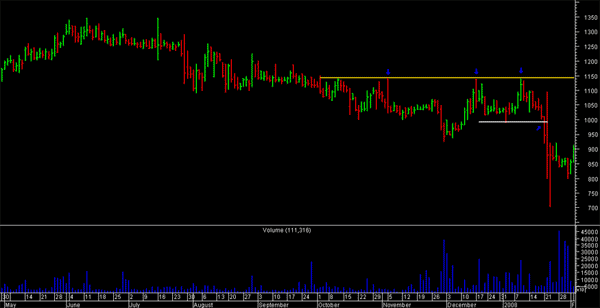Triple Top
The triple top is a reversal pattern made up of three equal highs followed by a break below support. In contrast to the triple bottom, triple tops usually form over a shorter time frame and typically range from 3 to 6 months. Generally speaking, bottoms take longer to form than tops. We will first examine the individual parts of the pattern and then look at an example.
Prior Trend: With any reversal pattern, there should be an existing trend to reverse. In the case of the triple top, an uptrend or long trading range should be in place. Sometimes there will be a definitive uptrend to reverse. Other times the uptrend will fade and become many months of sideways trading.
Three Highs: All three highs should be reasonable equal, well spaced and mark significant turning points. The highs do not have to be exactly equal, but should be reasonably equivalent to each other.

Volume: As the triple top develops, overall volume levels usually decline. Volume sometimes increases near the highs. After the third high, an expansion of volume on the subsequent decline and at the support break greatly reinforces the soundness of the pattern.
Support Break: As with many other reversal patterns, the triple top is not complete until a support break. The lowest point of the formation, which would be the lowest of the intermittent lows, marks this key support level.
Support Turns Resistance: Broken support becomes potential resistance, and there is sometimes a test of this newfound resistance level with a subsequent reaction rally.
Price Target: The distance from the support break to highs can be measured and subtracted from the support break for a price target. The longer the pattern develops, the more significant is the ultimate break. Triple tops that are 6 or more months old represent major tops and a price target is less likely to be effective.
Throughout the development of the triple top, it can start to resemble a number of patterns. Before the third high forms, the pattern may look like a double top. Three equal highs can also be found in an ascending triangle or rectangle. Of these patterns mentioned, only the ascending triangle has bullish overtones; the others are neutral until a break occurs. In this same vein, the triple top should also be treated as a neutral pattern until a breakout occurs. The inability to break above resistance is bearish, but the bears have not won the battle until support is broken. Volume on the last decline off resistance can sometimes yield a clue. If there is a sharp increase in volume and momentum, then the chances of a support break increase.
When looking for patterns, it is important to keep in mind that technical analysis is more art and less science. Pattern interpretations should be fairly specific, but not overly exacting as to obstruct the spirit of the pattern. A pattern may not fit the description to the letter, but that should not detract from its robustness. For example: it can be difficult to find a triple top with three highs that are exactly equal. However, if the highs are within reasonable proximity and other aspects of the technical analysis picture jibe, it would embody the spirit of a triple top. The spirit is three attempts at resistance, followed by a breakdown below support, with volume confirmation. ROK illustrates an example of a triple top that does not fit exactly, but captures the spirit of the pattern.









